
About our City
Mysore City Palace and Museum
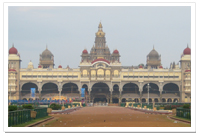
The palace at the heart of the city forms the focal point around which the city functions. Located at Mirza Road, the Palace is open daily from 10:00 a.m. - 5:30 p.m. Entry fee - Rs.10. Shoes cannot be worn inside the palace. Camera not allowed. The palace is illuminated on Sundays, national holidays from 7:00 p.m. to 8 p.m. and during Dassera festival from 7:00 p.m. to 9 p.m.
One of the largest palaces in India and the residence of the Wodeyar Maharaja's of the Mysore state, it was designed by British architect Henry Irwin and built in 1912, after a fire burnt down the old wooden palace. The stained glass roof of the 'Kalyana Mandapa' (marriage pavilion), wall paintings, ivory inlaid rosewood doors and the ornate golden throne here, are all remarkable.
The palace now under the supervision of Department of Archaeology and Museums of the Karnataka Government is converted into a museum. The royal costumes, children's toys, musical instruments, photographs and numerous portraits are placed at the ground floor. A small collection of weapons are displayed on the upper floor.
Chamundi Hill
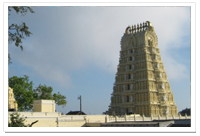
The 1150 meter Chamundi Hill is one of the landmark tourist attraction of Mysore. It is located about 13kms South east of Mysore.
The Chamundeswari temple on the top of the hill, dating back to the twelth century, is dedicated to Durga Devi or goddess Chamundi (avatar of Parvathi, Shiva's consort) for celebrating her victory over the demon Mahishasura. The idol of goddess Chamundi inside the sanctorum sanctuary is in solid gold. The temple is a fine example of Dravidian temple architecture. The temple tower is 40m high with seven stories. Behind the main temple there is a small shrine dedicated to Mahabaleswara which is over a thousand years old. From the top of hill you can have a panoramic view of Mysore. There is a giant statue of Mahishasura, the demon who was killed by the goddess Chamundi (Durga Devi) near the temple. Halfway up the hill a ornamented monolithic statue of the Nandi Bull can be found. It is carved out of a single block of black granite.
Saint Philomena's Church

Built in 1933 and designed by Reverand Rene Feuge, St. Philomena's church is one among the grandest churches in India. Located about 3 kms from the city on Cathedral road, it is the tallest Church in India built in the neo-Gothic style. A statue of 3rd century saint, Philomena is placed in an underground chamber. The twin spires are 175 feet in height and are visible from miles around. Some fine attractive glass paintings depicting scenes from the birth of Christ, the Last Supper, the Crucifixion, the Resurrection and the Ascension of Christ can also be seen here. Presently it is known as St. Joseph's Church. Open from 8 am to 6 pm.
Jaganmohan Palace
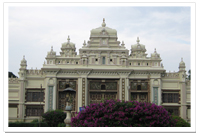
Jaganmohan Palace, built in 1861 by Maharaja Krishnaraja Wodeyar, is one of the oldest building in Mysore. This three storied palace with stained glass shutters and ventilators is located about 10 minutes walk from the city bus stand. It is now converted into Jayachamarajendra Art Gallery, a treasure house of paintings of unparalleled beauty, handicrafts, a rare collection of musical instruments and historical memorabilia dating back to the nineteenth century and earlier.
Mysore Zoo
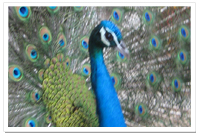
This century-old Zoo houses nearly 2000 animals. It has the distinction of breeding wild animals in captivity. This garden stands to the east of the fort at a kilometer. It owes its origin to his Highness Sri Chamaraja Wodeyar Bahadur, but it has been greatly enlarged and improved recently.
The very extensive grounds are beautifully laid out, and kept in axcellent order. All the animals in Zoo are well fed, well kept and generally healthy. Arrangements are made for some of the animals, especially for Lions and Tigers, to roam about in liberty. There is a fine collection of animals, birds and snakes, which include Lions, Tigers, Rhinos, Kangaroos, Hyaena, Deer, Elephants, Peacocks, Swans, Pythons, King Cobra, etc., Recent-tly they have added a snake park. There are a few articial lakes in the Zoo. A visit to these gardens is extremely thrilling.
Karanji Kere
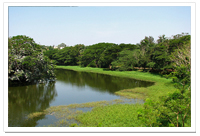
The lake is surrounded by a nature park consisting of a butterfly park and a walk-through aviary. This aviary is the biggest 'walk-through aviary' in India. There is also a museum, the Regional Museum of Natural History which is located on the banks of this lake. The total area of Karanji lake is 90 hectares. While waterspread area is about 55 hectares, the foreshore area measures about 35 hectares. Karanji lake is owned by the Mysore Zoo Authority.
Jayalakshmi Vilas Palace
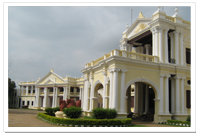
Jayalakshmi Vilas, located in the lush green landscape of the University of Mysore around 5 kilometers to the west of the city reflects the rich architectural splendor of the ancient times. Built in 1905 as the mansion of the eldest daughter of Maharaja Chamaraja Wodeyar, the palace was known as Rajkumari Mansion. The building itself is made up of a three wing structure but so connected as to give the appearance of a single massive structure. The north and south portion of this structure is connected with a small over bridge and the interior have extensively rich carvings and mouldings of ancient Indian design. Other architectural features like the twin Corinthian and ionic columns, regal pediments, pilastered window-sets and oval ventilators adds to the grace and glory of this huge monument.
A dancing hall with a wooden floor and a 12 pillar, square Kalyana Mantapam are the major attractions of the palace which represent the zenith of artistic caliber of the local craftsman of the bygone golden era. The 40 x 25 feet dancing hall has a viewers gallery and a first floor, and the 40 feet high roof at the central portion is decorated with painted glass. The Kalyana Mantap, the most beautiful portion of the mansion, has an eight-petal shaped dome with glass windows and a gold -plated 'Kalasha" or tower on top.
Besides the main entrance, the mansion has entrances on each side, different from each other. The entrance on the northern side has an extrusion on the stairs probably to be used as an alighting platform from cars and chariots. At the centre of the main building, there is a small courtyard with a fountain. The north side pediment of the mansion has a sculpture of the Goddess Lakshmi and the south side has a sculpture of Goddess Bhuvaneswari under a domed canopy.
Renovated in 2002, Jayalakshmi Vilas is now a part of the Mysore University and has been converted to a museum (Folklore museum) and a research center of the University. The exhibits in the museum include priceless collection of artifacts, folklore, archaeology and geology, collected from various parts of India etc. The research center offers the students to carry their projects on several important topics with much ease and convenience.
Krishnaraja Sagar Dam or KRS Dam

KRS dam, built in 1932, is located 12 kms north-west of Mysore. The project was designed by the farsighted engineer Sir M. Vishweswaraiah and constructed during the rule of Krishnaraja Wodeyar IV. The dam is around 8600 feet long and 130 feet high with a reservoir spread over an area of 130 sq.kms. It represents a marvel of civil engineering achievement in pre-independence India and was among the first in the world to use automatic sluice gates. There is a boating pond to cross the dam from the south bank to the north bank and at the northern edge are the dancing fountains. The beautiful terraced Brindavan Gardens is located just below the KRS dam.
Ranganathittu Bird sanctuary
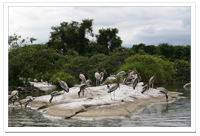
This place is about 13 KMs towards North-East to the city of mysore. This bird sanctuary is located on the backwaters of river Kaveri. Nature has made small islands here to facilitate the birds to stay and breed here. Birds from far off places like Siberia, North America migrate here every year to breed new ones and fly back to their own place. The Department of Forests has made arrangements of boating inorder to watch the birds. Every year during May and September you can see large variety of birds here.
Sangam

Sangam is a spot 3 km away from Srirangapatna where the other branch of the river Cauvery - Loakpavani is reunited in jubilant enthusiasm. The Sangam is otherwise known as the confluence of rivers. It is located near a temple. A dip in the Sangam is considered to be holy. There is a common belief among people that their sins can be washed away by this holy dip. This is an admired picnic spot and is a exquisite place. From here the river Cauvery flows into the Mettur Dam in Tamil Nadu.
Gumbaz
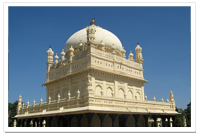
Mausoleum of Tippu Sultan, and his father Hyder Ali and mother Fathima Begam. This was built by Tippu Sultan between 1782-84, the Gumbaz, an imposing structure in the midst of the Lalbagh garden, stands on a high and wide platform with an open verandah of polished pillars all round. The importance of Gumbaz lies in its well-shaped large dome, ivory inlaid doors, carved stone windows of fine workmanship and inscriptions. Tipu's favourite Tiger stripes cover the walls.Inside are the tombs of Haidar in the center, his wife and his son Tippu on either side. In the verandah and on the platform are the other tombs of Haidar's family members.
Ranganatha swamy Temple
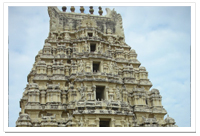
The temples is one of the most important Vaishnavite shrines in South India. It is built by the Gangas in 9th century, later improved by the Hoysala and Vijayanagar kings. The temple is a tribute to Lord Ranganatha(Vishnu ) has been dedicated at three pilgrimages.
- Adi Ranga at Srirangapattana
- Madhya Ranga at Shivanasamudra
- Antya Ranga at Srirangam
Nanjangud
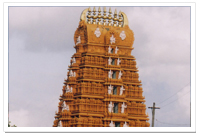
This place is 25 KMs towards south of Mysore on the way to Ooty. This is a place of worship and is located on the banks of river "KAPILA" . The temple here is of prime importance, which is the temple of "Lord Shreekanteshwara" (Shiva). The temple here is one of the largest temples of south India. The temple is spread around 1 Acres. There are 121 statues of Shiva in different avatars, also there are 65 Lingas. There will be festival during March and April where lakhs of devotees gather for the occasion.


